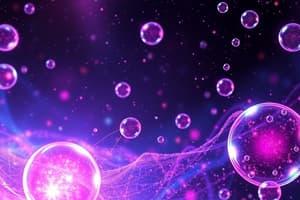Podcast
Questions and Answers
What is the atomic mass of Carbon?
What is the atomic mass of Carbon?
- $12$ (correct)
- $20.18$
- $6.941$
- $6$
What is the number of neutrons in a Carbon atom?
What is the number of neutrons in a Carbon atom?
- $6$
- $18$
- $12$ (correct)
- $6$
How many protons are in a Calcium atom?
How many protons are in a Calcium atom?
- $20$ (correct)
- $20$ (correct)
- $40$
- $60$
What is the definition of an ISOTOPE?
What is the definition of an ISOTOPE?
What is the purpose of a particle accelerator?
What is the purpose of a particle accelerator?
How many vacancies were there in the periodic table in 1925?
How many vacancies were there in the periodic table in 1925?
What did Henry Gwyn-Jeffreys Moseley demonstrate about the atomic number?
What did Henry Gwyn-Jeffreys Moseley demonstrate about the atomic number?
What was the highest atomic number of known elements in the 1930s?
What was the highest atomic number of known elements in the 1930s?
What is the definition of a transuranic element?
What is the definition of a transuranic element?
How important was the formation of elements in our solar system?
How important was the formation of elements in our solar system?
Where do the atoms and molecules that make up your body come from?
Where do the atoms and molecules that make up your body come from?
Flashcards are hidden until you start studying
Study Notes
- Henry Gwyn-Jeffreys Moseley, an English physicist, established the relationship between the atomic number (number of protons) and the properties of an element.
- In 1919, Ernest Rutherford achieved a nuclear transmutation reaction, transforming one element into another, showcasing the process.
- The Periodic Table is arranged based on atomic number, electron configuration, and chemical properties of the elements.
- Synthetic elements are radioactive, with transuranic elements having atomic numbers greater than 92 and superheavy elements beyond 103.
- Supernovae play a crucial role in the formation of elements in our solar system, highlighting their significance.
- Elements in the human body, including protons, electrons, and neutrons, originated from the Big Bang, raising questions about their birthdates.
- Atoms are the smallest units of matter forming chemical elements, with electrons carrying a negative charge and protons a positive charge.
- The atomic number, representing the number of protons, serves as the identity of an atom, while the atomic mass is the sum of protons and neutrons.
- Isotopes are atoms with the same atomic number but different atomic masses, with some elements being synthesized using particle accelerators in 1925.
Studying That Suits You
Use AI to generate personalized quizzes and flashcards to suit your learning preferences.




